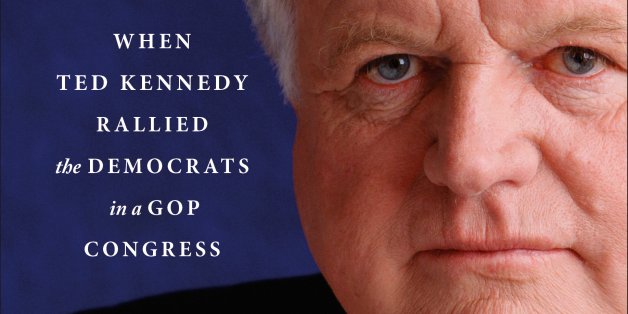
Lion of the Senate: When Ted Kennedy Rallied the Democrats in a GOP Congress
Nick Littlefield and David Nexon (New York: Simon & Schuster, 2015)
Reviewed by: B. J. Smothers
History never exactly repeats itself. There’s always a little wrinkle that makes the difference. In 1994, when Newt Gingrich rose to power, he marked his territory by orchestrating the Contract with America, threatening to eviscerate New Deal and Great Society legislation. Six weeks before the 1994 election, he gathered Republicans on the steps of the Capitol (as Reagan had done to celebrate passage of the Reagan tax cut) to introduce Gingrich, Dick Armey, and political adviser Frank Luntz’s Contract with America and to launch the next assault on progressivism. In the subsequent GOP rout, after forty years of being in the minority, Republicans had flipped that position in the House, 228–207, and in the Senate, 52–48. To make matters even worse, two senators and several House Democrats defected to the Republican Party after the election. Democrats were stunned, deflated, and President Clinton was promising to work with a Newt Gingrich controlled Congress. But then, there was the indomitable Ted Kennedy to act as a shield between U.S. citizens in need and the powerful. The means by which this contest played out is detailed in Lion of the Senate.
The authors were both eyewitnesses to this historic time in U.S. political history. Nick Littlefield was a federal prosecutor in New York and then a partner in a Boston law firm before becoming Sen. Kennedy’s chief of staff for the Senate Health, Education, and Labor Committee (1989–98). He is the major author. As the manuscript neared completion, David Nexon, Sen. Kennedy’s senior health policy adviser and director of Kennedy’s Health, Education, Labor and Pensions (HELP) Committee (1983–2005), became Littlefield’s coauthor. Both came to work for the “preeminent activist legislator of his time,” at salaries much below what they could have earned in the private sector. But as formidably intelligent people became a part of Kennedy’s staff to advance his progressive agenda, the other side attracted dedicated conservatives to oppose it. During the run up to the 1994 election, Kennedy faced a stiff challenge in Massachusetts from the handsome, well-heeled conservative Mitt Romney.
Initially, the Romney campaign cast doubts about the election’s outcome. While Romney was out campaigning for most of 1994, Kennedy was in Washington executing his senatorial work and, especially, devoting time to Clinton’s universal health insurance plan. His attention became fixed on Romney in the final months when, according to Littlefield, he had to take out a million dollar loan on his Virginia house to meet the Romney challenge. On the night of the election, Kennedy was jubilant with a 58 to 41 percent victory over Romney. When the national election results came in, Kennedy’s victory was overshadowed by the huge Democratic defeat throughout the nation, including high profile governorships, e.g. the fall of Mario Cuomo of New York and Anne Richards of Texas (to newcomer George W. Bush).
During this period, ultraconservative, oversized, populist provocateur Gingrich had been kept in reasonable check, until that historic election. Once he came to power as Speaker of the House, all the bluster became reality. His Contract with America (much as the Make America Great Again of D. Trump) threatened to significantly revamp U.S. society, asserting a hard conservative agenda that would change relationships among U.S. citizens. The Contract laid out a ten-point program that Gingrich pledged to enact in the first hundred days of the new term. According to Littlefield and Nexon, “it appealed to the Republican base as well as white low and middle-income Democrats, including blue-collar workers” and played on perceived fears of “free riders on welfare, suburbanites frightened by crime and other urban problems, and the religious right.” In an interview with a CNN reporter, Gingrich remarked that he “expect[ed] a ten to twelve-year battle between conservatives and leftist elites over the direction of the country, before conservatives would be able to recast the government as a force for traditional morals” (Qtd in Littlefield and Nexon). It’s reasonable to assume that this battle will be ongoing as long as there are Democrats and Republicans, as long as one side is multi-colored and the other mainly white.
The centerpiece of the Contract was the Fiscal Responsibility Act. As with all its points, the devil is in the diction: any opposers must be irresponsible. This commandment called for a balanced budget, which would result in a dramatic cut back of government, i.e., cutting back on critical social programs, e.g., Medicare and Medicaid, student loans, and food programs. In brief, the other commandments were as follows:
(2) Taking Back Our Streets Act, emphasizing punishment and enforcement and targeting black “criminals”; (3) Personal Responsibility Act, a racial profiling of welfare, directed at single mothers; (4) Family Reinforcement Act, allowing a $5,000 tax credit for a family adopting a child; (5) American Dream Restoration Act, making available a $500 per child tax credit to offset the “marriage penalty”; (6) National Security Restoration Act, increasing military spending; (7) Senior Citizen Fairness Act, offering a modest cut in taxes on Social Security benefits for middle- and upper-income seniors; (8) Job Creation and Wage Enhancement Act, providing significant tax cuts for the wealthy and business but “scaling back the government’s ability to issue regulations to protect workers from unsafe practices, consumers against unsafe products, and the environment from industrial pollution” and reducing taxes on capital gains; (9) Citizens Legislation Act, limiting terms; and (10) The Common Sense Legal Reform Act, imposing reforms that would significantly affect federal civil litigation and impacting the civil justice process.
Obviously, improving public schools, making college more affordable, extending health care, or alleviating the pressures of workers and the middle class beyond minimal tax cuts were not responsible pursuits. Gingrich pledged to “read the Contract with America in the House at the start of business . . . for the first hundred days” and would work around the clock “to secure passage of every item.” At that time, Gingrich notoriously declaimed that he was “prepared to cooperate” but “not prepared to compromise” with President Clinton. In other words, it’s my way and you can make suggestions on how to execute my way. Littlefield also reports that Gingrich suggested that “poor children who weren’t doing well with their parents should be removed from their families and sent to orphanages.” Even staunch conservatives would have to admit that the Contract was intimidating, I imagine. The Democrats certainly felt the rage. They embraced poor children, public schools, and working families. While they tried to fathom the reasons behind their historic loss, Kennedy might as well have said, “Forget all that and move on.” The day after the election, he had decided to fight.
The major theme of the authors’ narrative is that fighting injustice was an innate part of Kennedy’s character, but that he would not enter any fray without a strategy, without a winning plan. The steps of a Kennedy strategy fell into three parts: substance, politics, and public relations. Substance consisted of getting to know all angles of the issue thoroughly to prepare to confront it. This step entailed exhaustive research by the staff and then gathering information from experts, in the subject area, usually in a discussion termed an “issue dinner.” For example, to gain insight on the results of the 1994 election, Kennedy and staff sought the expertise of historians, Columbia University’s Alan Brinkley and Pulitzer Prize winner Doris Kearns Goodwin; the former chief of staff to Massachusetts governor Michael Dukakis, John Sasso; and American Prospect editor Robert Kuttner. The chief components of politics was an “inside game” and an “outside game.” Inside meant marshaling the support of both Republicans and Democrats through relationships the senator had built over years. The outside game referred to grassroots support for the plan across the U.S. (e.g., in confronting the Trump assault on civil liberties, Bernie Sanders reaching out to his base and beyond). Lastly, the third component, public relations, was the costly one. According to Littlefield, Kennedy and staff focused on the free press. It also entailed producing staff reports that could be released to the press, publicizing polls and so forth.
In the aftermath, no longer the majority in the Senate, executing the daily tasks must have been daunting. Kennedy headed the Labor Committee and, before the defeat, was able to create a staff that was one of the largest in the Senate. And he required such a staff to address his wide-ranging progressive agenda. After the election, Littlefield reports that, instead of the expected 50 percent budget cut for staff, the Republicans cut Kennedy’s staff by 75 percent. Still, he wanted to pass major legislation on the minimum wage, student debt, and health insurance (his ultimate plan was universal healthcare). He intended to push forward, but he had to win over President Clinton. The authors characterize that task in the chapter title in which it’s discussed: “The Struggle for the Mind of the President.”
Kennedy had to keep Clinton on the course of a progressive agenda, if Gingrich’s damage would be mitigated. The conservative, Republican leaning political consultant Dick Morris was advising Clinton to move toward the center and devise his own budget-balancing scheme. Morris coined a phrase for his Clinton strategy—“triangulation.” In preparing to meet with Clinton before his radio address on December 15, which would partially preview the State of the Union speech in January, Kennedy was well prepared, even sounding out Clinton’s staff prior to the meeting. In a discussion with Alice Rivlin, director of the Office of Management and Budget (OMB), he asserted that the “president needs to come to grips with whose side he’s on.” To Leon Panetta, then Clinton’s chief of staff, he pointedly said, “Don’t hurt the poor by cutting Medicaid.” Further, Kennedy prepared to frame much of the conversation with Clinton on his own strategy in winning his election against Romney while other Democrats were losing in troves. Above all, he certainly planned to stop Clinton from flirting with his balanced budget plan that would “out-Republican the Republicans” by proposing tax cuts and “transferring power from the federal government back to the states.”
The narrative meticulously takes readers inside the workings of a senator and his staff. Yet, the work is not a dry recitation of events, because levity is brought to the story in details that bring readers into the living spaces. For example, in the waiting room of the West Wing of the White House, there’s the M&Ms jar, “on a table to the left of the door as your entered from outside,” kept full by a marine guard. Littlefield confesses that on some visits “he plotted how to get back and forth to the M&M jar without appearing to be too greedy.” Still, the passage’s main event is not overshadowed, i.e., the back and forth discussion between Kennedy and Clinton as Kennedy fully engaged his quarry. When Kennedy left, he had made all the points in his memo outline, which he left behind. And we have words and visuals of that meeting. As for the result, though Clinton’s radio address did not follow through on every item of their discussion, it did offer up his own “middle class bill of rights,” which centered on the middle class and not the upper class and/or business as the Contract did. Moreover, Clinton had not gone near tax cuts through slashing Medicare or Medicaid benefits.
In 1995, the Republicans passed a reconciliation bill to balance the budget that included significant cuts to Medicare, Medicaid, and nursing home and added significant taxes on student loans. Clinton stood firm with a veto. The drama continued with the Republican debt limit extension and continuing resolutions. Again, Clinton stood firm—it was unavoidable on his part because the offer forthcoming included a 40 percent cut in “health, education, commerce, housing, veterans, and labor programs.” There were two shutdowns and numerous temporary funding measures, but the Contract had been met and, essentially, defeated. Revealingly, the public didn’t support the shutdowns or the agenda reflected in the Contract. For the public, the GOP was “the party that had no compassion.” As many will recall, George W. Bush didn’t forget—he campaigned as a “compassionate conservative.”
The outcome for the 103rd Congress was a far cry from the demoralized mood after the 1994 election. The Family and Medical Leave Act, Head Start expansion, Elementary and Secondary Education Act, School-to-Work, student loan reform, and the National Service Program were passed. Clinton, as portrayed here, was torn between his progressive values and his desire to end the gridlock over the budget and set himself up for victory in his 1996 campaign. But he finally stood up for those values. Littlefield concluded “All in all, Democrats came out way ahead after this long, contentious, difficult year. The Republicans were blamed for the government shutdown. They had lost big. And any Democrat who did not see how to defeat the radical right was not paying attention.”
A week after the death of his mother Rose Kennedy, in 1995, Ted Kennedy returned to Washington and joined a gathering of Senate and House Democrats to discuss their agenda. The subject was whether to back off an increase in the minimum wage due to the political climate. Again, many Democrats were worried about re-election. Kennedy listened patiently, taking in the extent of their woes, before lashing out, “I can’t believe what I’m hearing. . . . If we are not going to fight for the wages of working people, who will fight for them? . . . Who are we afraid of?” He continued, his voice rising, “We can’t get behind a measure that has 85 percent popularity in the polls, then our heads aren’t screwed on right. . . . We can’t be for it because it has no chance of success? Because the Republicans say there never should have been a minimum wage . . . and they’ll fight the increase with every fiber of their being? Well I say, bring on the fight! . . . ” After a long silence, Illinois Senator Dick Durbin spoke, “Well, I guess we now understand how Ted feels about this.” And what was the proposed increase? Kennedy wanted $1.50 an hour, spread over three years; others proposed 75 cents, over three years. Eventually Kennedy secured 90 cents over two years—45 cents per year. But to truly understand this exchange, one should look to the record, which shows that he led the fight to increase the minimum wage on numerous other occasions, moving it from $2.30 an hour in 1978 to $7.25 in 2009.
The minimum wage encounter brought to my mind an anecdote Littlefield related at the beginning of the book. On a set schedule, Kennedy held these early morning tennis matches. They began at 7:30 a.m. sharp, no warm up, and straight to the doubles match. The senator would usually pair with the best tennis player to gain, of course, a better opportunity to win a match, given his compromised ability to maneuver on a tennis court. Diminished ability did not deter Kennedy from using the skills he still had and bolstering his weaknesses with the strengths of his partners. The matches promptly concluded at 8:45 a.m., regardless of score, and all would have a breakfast of “English muffins, strawberry jam and rashers of bacon . . . ” The lesson: never let compromises stop the game but use them to better the outcome. I recall his cultivating relationships with Republican senators: Orrin Hatch to create the Hatch-Kennedy Children’s Health Insurance Program (CHIP) and Nancy Kassebaum for the Kassebaum-Kennedy Health Insurance Reform Act of 1996.
History does not overlook what has happened in the unraveling of time; the treasured events sit like books on a shelf until we reach back to remember. Who remembers how Clinton feared the Republicans after that 1994 election, after they framed the loss on him? After the 2016 election, I recall the anguish on Bill Clinton’s face as he stood behind Hillary Clinton, who had to take the fall at the hands of another oversized, populist provocateur. In this reign of Trump, is there a lion in the senate or elsewhere to come to our rescue? The qualities of such a leader are stiff. From Littlefield and Nexon’s character study of Ted Kennedy, one must be highly intelligent, courageous, and charismatic. In this class-conscious country, it doesn’t hurt if one is to the manor born and stepping back from a fight is anathema to one’s character.
***********************************
Suggestions for Teaching
This text would be ideal for a LIBS 201 course. The components are clear: social justice theme, oppressed groups, and systematic oppression. It would also be effective in public speaking, public policy, and history courses.

